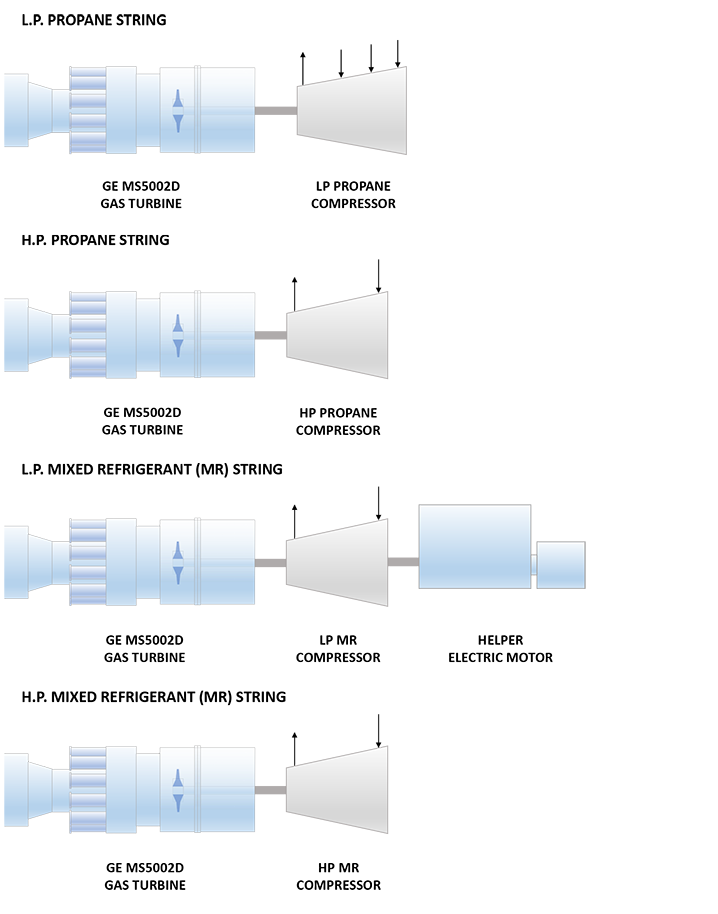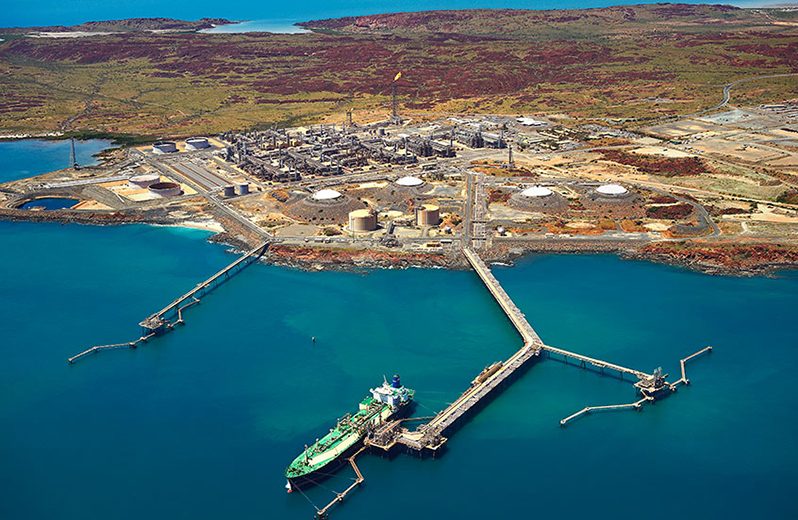The establishment of Woodside (Lakes Entrance) Oil Co NL in 1954, followed by the permission to explore 370,000 square kilometres off Western Australian coast in 1963 and the formation of the North West Shelf Venture, are not only significant milestones in the history of the Karratha Gas Plant but also in the history of LNG in Australia. In 1968, Woodside first found oil in the NW Shelf, followed by major gas and condensate discoveries in 1971. In 1980, construction of an onshore gas plant was commenced in Burrup Peninsula, which at that time was the largest single non-government project ever undertaken in Australian history. The Karratha Gas Plant was built approximately 1260 kilometres north of Perth.
The signing of sales agreements with 8 Japanese gas and power companies in 1985 opened the way for construction of an LNG plant, which initially housed 2 LNG trains of capacity 2.2 MMTPA each. Production started in 1989 and in 1992 the trains were modified to enhance their capacity to 2.5 MMTPA per train. The very same year, train 3 came on stream with a similar production capacity. Major expansion plans were initiated in the year 2000, backed by signing of letters of intent with the Japanese buyers. In 2002, a 25-year contract was signed with China for the supply of LNG from the plant. The facility added 4.4 MMTPA capacity in 2004, when train 4 commenced production. In April 2007, Woodside initiated phase V expansion at Karratha, which involved the construction of train 5 and associated infrastructure upgrades at the facility. The A$2.6 billion investment concluded with train 5 adding another 4.4 MMTPA capacity in 2008.
In the last 30 years the North West Shelf project has shipped over 5000 cargos. The project, which is spread over 200 hectares, is not only one of the largest in the country, but also delivers a third of Australia’s oil and gas production. It is one of the most advanced, integrated gas production systems in the world, with 5 LNG trains, 2 domestic gas trains, 6 condensate stabilization units and 3 LPG fractionation units. Gas is supplied from several fields including Goodwyn, Waneae, Rankin, North Lambert, Hermes and Cossack and also tiebacks from Echo-Yodel and Perseus. Two 130km trunk lines transport gas to the facility.
Woodside aims to contribute significantly to the local community and funds initiatives in 3 categories – philanthropy, strategic shared value partnerships and driving collective impact. Through employee volunteering & participation programs, collaboration with the community and working with government and industry, the company continues to forge stronger ties with the community. The facility employs a staff of 430 personnel and is committed to providing full, fair and reasonable opportunities to the indigenous community. Woodside claims to direct 80% of its overall spending to Australian businesses and in 2017 witnessed a 34% increase in new contracts awarded to indigenous businesses.
The company actively funds and works with scientific studies and research programs to deepen the understanding of the regional environment and how it is affected by human impact. The program with the Australian Institute of Marine Science at Scott Reef, is one of the longest and most comprehensive investigations of a reef system in the world. For three years in a row (2015, 2016 and 2017) Woodside has received the Australian Petroleum Production & Exploration Association environment excellence award. In 2018, the Dow Jones sustainability index ranked Woodside in the top 7% companies in its sector.
OWNERSHIP (Equity %)
| Woodside Energy | 16.67% |
| BHP Billiton | 16.67% |
| BP Developments Australia | 16.67% |
| Chevron Australia | 16.67% |
| Japan Australia LNG (Mitsubishi Mitsui) | 16.67% |
| Shell Development (Australia) | 16.67% |
General Data
| Estimated Capital Cost (USD) | NA |
| Plant Type | Onshore Stick-built |
| Plant Stage | Operating |
| Final Investment Decision (FID) Year | Train 1 & 2 – 1985 Train 3 – 1998 |
| FEED Contractor | M. W. Kellogg Limited (KBR Inc.) Hatch-Kaiser Engineers Clough Engineering JGC Corporation |
| EPC Contractor | M. W. Kellogg Limited (KBR Inc.) Hatch-Kaiser Engineers Clough Engineering JGC Corporation |
| No. of Trains / capacity | 3 Trains / 2.5 MMTPA each |
| Production Start Year | 1989 (Train 1) 1989 (Train 2) 1992 (Train 3) |
| Products | LNG, LPG, Condensate, Domestic Gas, Oil |
| Gas Type | Non-associated Gas (NAG) |
Technical Data
| Cooling Media | Air (First 100% air cooled LNG plant) |
| Liquefaction Technology | APCI AP-C3MR™ |
| Refrigeration Train Details: | |
| Low Pressure (LP) Propane String | |
| Driver | GE MS5432D (Frame 5D) Heavy Duty Gas Turbine (Upgraded from GE MS53382C) |
| LP Propane Compressor | 3MCL1003 GE (Nuovo Pignone) Horizontally Split Centrifugal Compressor |
| High Pressure (HP) Propane String | |
| Driver | GE MS5432D (Frame 5D) Heavy Duty Gas Turbine (Upgraded from GE MS53382C) |
| HP Propane Compressor | MCL1002 GE (Nuovo Pignone) Horizontally Split Centrifugal Compressor |
| Low Pressure (LP) Mixed Refrigerant (MR) String | |
| Driver | GE MS5432D (Frame 5D) Heavy Duty Gas Turbine (Upgraded from GE MS53382C) |
| LP MR Compressor | MCL1004 GE (Nuovo Pignone) Horizontally Split Centrifugal Compressor |
| Starter/Helper | |
| High Pressure (HP) MR String | |
| Driver | GE MS5432D (Frame 5D) Heavy Duty Gas Turbine (Upgraded from GE MS53382C) |
| HP MR Compressor | BCL607 GE (Nuovo Pignone) Radially Split Centrifugal Compressor |
| Power Generation | 6 x GE MS5001P Heavy Duty Gas Turbine Generators |
Refrigeration Train Configuration

Key Facts
- The Northwest Shelf LNG project was designed with the APCI C3MR cycle and employs Frame 5 gas turbines instead of the traditional steam turbine drives. In 1989, it became the first LNG plant to have air-cooled heat exchangers instead of sea water cooling. At a marginally extra cost, this design provided significant environmental benefits imperative to the sensitive neighborhood. The NWS Project is a pioneer in the optimization of LNG production from an air-cooled plant and a model example for future gas turbine driven LNG plants.1,2
- The unique Remote Offshore Warning System (ROWS), developed by Woodside to predict cyclone-generated waves in Mermaid Sound, provides valuable insight into when an LNG carrier must set sail to avoid cyclonic disruptions. The system can forecast wave patterns almost 10 times more accurately than the conventional methods. With over a quarter of century in operation, ROWS contributes immensely to on-schedule loading, enhanced wharf efficiency and reduced tanker wait.2
- At the time of commissioning of the North Rankin A platform in 1984, it was the largest gas production platform in the world, capable of producing 1,815 million cubic feet of gas and 47,400 barrels (7,540 m3) of condensate per day. The platform located 135 km north-west of Karratha, can accommodate more than 120 people, and service 25 production wells in the North Rankin and Perseus fields. Subsequent modifications have increased its capacity by 50% and it continues to be one of the world’s largest gas platforms.3
- The first cargo from North West Shelf LNG was shipped in 1989, onboard the Northwest Sanderling, to Japan’s Sodegaura Terminal.3
- In 1992, The Western Legend – a research vessel (RV), conducted what was the biggest 3D seismic program in Australia. The vessel was one of the most sophisticated seismic vessels of the time and later in 2004, it was renamed to “Marcus G. Langset” after the Lamont scientist.3,4
- The fully integrated oil and gas project at Karratha delivers a variety of energy products to Australian and overseas markets. The export revenue in 1997 from all products was estimated at A$3 billion, which is close to 3% of Australia’s GDP. The North West Shelf Project accounts for one third of Australia’s oil and gas production. The project also delivers domestic gas to customers in Western Australia via the 1500 km Natural Gas Pipeline running from Dampier to Bunbury.5
- In 1995, the capacity of the 3 process trains was increased from 6.9 MMTPA to more than 7.5 MMTPA through successful debottlenecking. The process involved an effective turbine upgrade from GE Frame 5B to Frame 5C by employing Advanced Technology Parts (ATP). By 1996, the project enhanced its capacity to produce a total of 18 MMTPA of LNG, domestic gas, LPG and condensate.6
Source:
1. Nored M., Brooks A. ‘A Historical Review of Turbomachinery for LNG Applications’, 17th International Conference and Exhibition on Liquefied Natural Gas 2013 (LNG 17), 2013
2. ‘Nomination of the North West Shelf Project For an Engineering Heritage Australia – Heritage Recognition Award’, Engineers Australia Website, April 2017
3. ‘A history of achievement’, Woodside Australia Website
4. ‘YNO 226 – Western Legend’, Ulstein Website
5. Jamieson A. et al. ‘The North West Shelf Project – The New Millennium’, 12th International Conference & Exhibition on Liquefied Natural Gas (LNG 12), Perth, Australia, May 1998
6. W.J. Brehaut, M.J. Concannon ‘Australian LNG plant debottlenecked to 7.5 million tons/year’, Oil & Gas Journal Website, 1 August 1996






















































